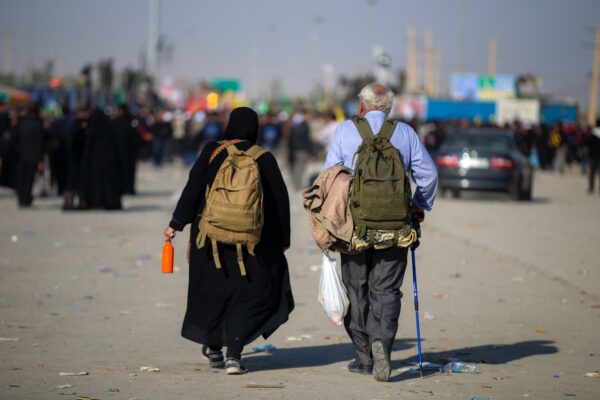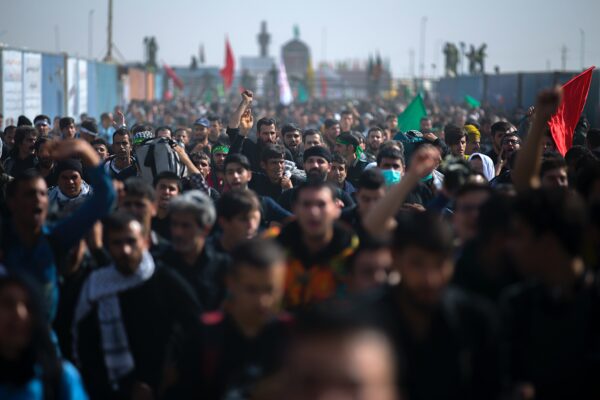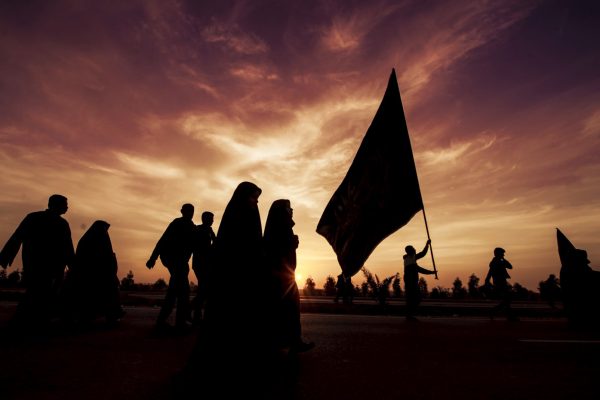The Day of Ashura marks the martyrdom of Hussain ibn Ali, grandson of the Holy Prophet, as he sacrificed his life for Islam. Learn more about the different ways Muslims mark this day
The Day of Ashura marks the martyrdom of Hussain ibn Ali, grandson of the Holy Prophet, as he sacrificed his life for Islam. Learn more about the different ways Muslims mark this day
The 10th of Muharram marks the day of Ashura. It is a sombre day for Muslims, particularly Shia Muslims, as it is the day Imam Hussain (as) – the grandson of the Holy Prophet (pbuh) – was martyred on the plains of Karbala.
The 10-day commemoration of his martyrdom, which begins on the 1st of Muharram, reaches its climax on Ashura day.
The martyrdom is largely commemorated in a similar way across Shia Muslims around the globe, with a few differences, which will be looked at in this blog including the significance behind each ritual.
Staying Awake All Night and Listening to the Tragedy
On the eve of Ashura, Muslims are encouraged to stay awake until Fajr time and listen to or read about the tragedy that took place on the day of Ashura. The purpose of this act is to show respect to Imam Hussain (as) and his companions, however, the deeper significance of this is that crying will soften the heart and prepare the individual for the rituals they need to perform on the day of Ashura to ensure they’re being done with feeling and presence of mind.
Furthermore, crying and reflecting also helps one introspect themselves as Muslims and can be a cause of internal revolution and motivation to reform oneself, because Imam Hussain’s (as) mission was also one of reform, in his own words:
I never revolted in vain, as a rebel or as a tyrant, but I rose seeking reformation for the nation of my grandfather Muhammad.”
(Majlisi, Biharul Anwar, vol.44, p.329)
A lack of crying or emotion can lead to hard-heartedness, which is one of the key reasons that stops people from repenting or even feeling guilty about their sins.
Performing Recommended Prayers and Dhikr
In books such as that of Al-Kafi and Bihar Al-Anwar, there are many recommended prayers and dhikr to perform on the eve of Ashura. I won’t list each one but the point of the eve of Ashura is to be in vigil all night.
In Bihar Al-Anwar, book 95 it is mentioned that anyone who keeps vigil all night is like the one whose thawab (reward) equals 70 years of worship. This illustrates the importance of the night as the significance and magnitude of the worship performed in it is likened to that of laylatul-qadr during the holy month of Ramadan.
Keeping Away from Worldly Activity
Being a day of great grief, Muslims are advised to keep away from worldly activities in the same way they would in the case of death within their own family. Many Shia Muslims will book annual leave months in advance from their workplace. Others who run their own business will shut for the day and notify their customers/clients via email, posters and so on.
Laughing is also makruh (discouraged) as is generally talking about anything concerning the world such as business, sports etc. When greeting fellow Muslims with a salaam it is recommended to offer condolences by saying the following:
May Allah make our reward and your reward great, for our grief of Hussain (as). May He place us and you from those who help his cause with his representative, the guided Imam from the family of Muhammad (peace be upon them).”
‘The guided Imam’ in the above statement is in reference to Imam Mahdi (as), believed in by both Shia and Sunni Muslims. The common belief is that he is from the line of Fatima (as) daughter of the Prophet (as) making Imam Hussain (as) his grandfather and he will return in the end times to bring justice and peace.
For Shia Muslims, Imam Mahdi (as) will also avenge the death of Imam Hussain (as), not necessarily by literally killing his killers as they’re dead already, but more defeating the evil ideology they held, that is still present today.
Ziyarat Ashura
Ziyarat Ashura is recommended to be recited every day of the year, but particularly during Muharram and especially on the day of Ashura. In the Ziyarat, salutations are given to Imam Hussain (as), his family and companions as well as a dua to Allah (swt) to not forgive the people who killed Imam Hussain (as).
Avoid Food and Drink Until Asr Prayer
Whereas Sunni Muslims fast on the day of Ashura, Shia Muslims keep away from food and drink until Asr prayers and so the intention is not to fast. This is done to try and feel a glimpse of the thirst and hunger felt by Imam Hussain (as) and his family and companions, who had access to water cut off by Yazid from 7th Muharram until the day of Ashura. This continues until Asr because it is believed the battle lasted until around then.
Retracing the Steps of Imam Hussain (as) Upon the Martyrdom of His Six Month Old Baby
Amongst the bitterness of the tragedy, the most heart-wrenching moment was when the enemies shot an arrow at Imam Hussain’s (as) six-month-old child. Imam Hussain (as) had pleaded with the enemy to at least let the six-month-old have some water even if he and the others in his camp do not get any water. Further to this, the Imam offered to hand the baby to the enemies who can give it water before returning the baby to Imam Hussain (as) in case they were worried the Imam would use this as an opportunity to take some water for himself or other members in his camp.
Unfortunately, the enemies did not even allow this much and instead shot an arrow at the baby, killing him. After this incident, the Imam did not know how to return to the mother of this child and tell her what had happened. It is said, he would advance towards the tent of his mother and then return in hesitation and repeated this seven times (Husayn Wa’is al Kashifi, Rawdat Ash-Shuhada, page 343).
Shia Muslims reenact this difficult moment for the Imam (as) by taking steps forward and back seven times whilst reciting:
Inna lillahi wa inna ilayhi raji’un (verily we belong to Allah and verily to Him we return)”
(2:156)
Retelling The Story of Imam Hussain’s (as) martyrdom
As mentioned, the tragedy is commemorated across 10 nights or so. In the nights leading up to Ashura, details are given on how the Imam’s companions and family members were killed by the enemy. However, on the 10th day itself, a detailed account using the most reliable sources available is used to narrate how Imam Hussain (as) himself was martyred.
His martyrdom was bloody and gruesome, which brings the most emotions and tears out of the 10 days.
Thereafter, various mourning rituals take place across the Shia diaspora. Some of them include:
Running Between the Shrines of Imam Hussain (as) and Hazrat Abbas (as)
Imam Hussain (as) is buried in Karbala, Iraq and his stepbrother Hazrat Abbas (as) is buried within a few hundred meters of him. Hussain and Abbas have the same father, Imam Ali ibn Abi Talib (as), but different mothers Lady Fatima bint RasulAllah (as) and Ummul Banin (as), respectively.
Many locals and pilgrims will spend the day running between the shrines of Hussain and Abbas as part of the rituals. The brothers had a strong bond and were always by each other’s sides until death. The running is a form of respect and salutations to the brave heroes of Karbala.
Ashura Processions
Various Ashura processions will take place across the world. Crowds of people will gather and walk with banners, flags, and slogans containing the names of Imam Hussain (as) and those in his camp as a show of solidarity with the Imam.
Due to Covid-19 some of these may be restricted this year and were so last year, but usually, thousands of people turn up for the processions. It’s also seen as a statement to the evil regimes that exist today, that their time will also come and good will always prevail over evil.
The Beating of the Chest
Men and women will (in separate areas away from each other) gather in rows and beat their chests as a way of mourning the tragedy. This will be happening simultaneously with the recital of poetry and eulogy.
Muslims in other regions may also use chains and knives to self-flagellate. Scholars, however, highly discourage this practice and even make it haram due to it causing unnecessary self-harm.
Reenactment of the Tragedy
The battle of Karbala will be re-enacted in certain parts of the world, such as Iraq, in an attempt to bring the battle to life. Locals or actors will play various people who were there on the day, including Imam Hussain (as), however, whoever plays the Imam, his face will be covered by a white cloth as a mark of respect and due to it being forbidden to portray the Prophet or an Imam in media.
Pools of ‘Blood’
According to multiple sources (Tarikh Dimashq, Maqtal Khawarezmi, Dhakha’er al-‘Uqbā, Al-Šawa’eq Al-Muhreqah, et al), it is narrated that:
When Hussain was killed, the skies wept blood.”
Whether that is a literal or metaphorical weeping is up for debate, however, in places like Iran, this is commemorated by filling water fountains with red dye to represent blood.
Remembering the Tragedy Post-Battle
As the night falls, the mourning does not stop. Although Imam Hussain (as) and his camp have been martyred, the plight of the survivors including the Imam’s sister Sayeda Zainab (as) and son Imam Ali ibn Hussain (as) continues as they are taken as prisoners and paraded and tortured. They are permitted to return to their homes in Medina 40 days after the battle, with the majority of Shia Muslims remaining in a state of mourning for these 40 days.





